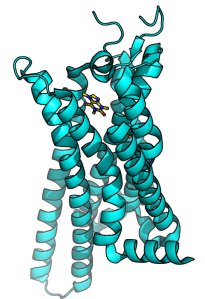Caffeine hit: Adenosine A2A receptor
What is it?
Espresso, cold press, café latte, flat white? Percolator, aeropress, capsule, instant? Single origin, blend, single estate? How do you like your daily coffee hit to be delivered?
Regardless of how you chose to consume your caffeine, its stimulant properties are the product of a common mode of action: namely the blockade of adenosine receptors in the brain. Adenosine receptor blockade disrupts the normal action of adenosine, a neurotransmitter with a role in wakefulness and locomotion. An additional knock on effect of reduced adenosine signaling is the release of adrenaline from the adrenal gland. Together these outcomes lead to many of the effects that we associate with caffeine consumption such as increased alertness, shakiness and an elevated heart rate.
Adenosine receptors have also been implicated in a number of neurodegenerative diseases including Parkinson's disease and Alzheimer's. Chemicals similar to caffeine but with improved properties and increased specificity of action have the potential to be used as treatments for these debilitating diseases.
Where did the structure come from?
This is the structure of the adenosine-A2A receptor in complex with caffeine1. The adenosine A2A receptor is a G-protein coupled receptor (GPCR). GPCRs are a family of membrane proteins that respond to a variety of extracellular chemical compounds to activate a range of specific responses inside the cell.
 What does it look like?
What does it look like?
The structure of the adenosine A2A receptor is typical of a GPCR, i.e. it has seven transmembrane spanning segments. Caffeine (yellow) binds within a cavity formed between the membrane spanning segments. Examining how caffeine binds and blocks the adenosine A2A receptor can help to inform the future design of new adenosine A2A receptor drugs.
This structure is Protein Data Bank ID 3RFM
References
1. Dore et al., Structure 19:1283-1293, 2011.






